Apple iPad mini with Retina Display: Reviewed
by Anand Lal Shimpi on November 16, 2013 8:00 AM ESTThe Display
The big story behind the new iPad mini is of course its 7.85-inch Retina Display. We’re talking about the same 2048 x 1536 resolution as the iPad Air, but in a much smaller form factor. The result is the highest pixel density of any Apple display ships today, tying with the iPhone 5S. The impact on the overall experience is pretty significant. Text is obviously a lot sharper, but even graphics are a lot nicer to look at on the new Retina Display. The gains aren't quite as obvious as they were on the larger iPad, but after living with the Retina mini for a while I can't easily go back to the previous version.

iPad mini (left) vs. iPad mini with Retina Display (right)
I ran Marco Arment's image retention test on the Retina mini and didn't see even the slightest degree of image retention. My old, non-Retina iPad mini on the other hand exhibited image retention. I suspect Apple is multi-sourcing its displays here, which could obviously contribute to varied behavior. At least on the two minis I have, image retention isn't an issue.
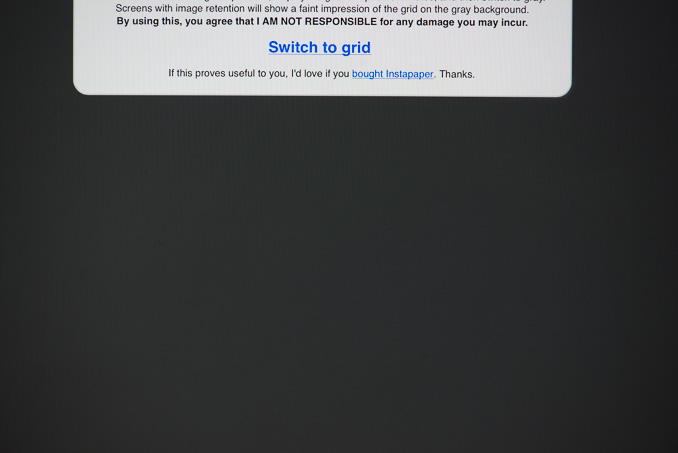
In the conclusion of my iPad Air review I wrote about the new mini as finally being a no-compromises smaller iPad. Much like my assertions last year of a Retina mini not being in the cards, it turns out that I was wrong on this point as well. Although display resolution is no longer a concern on the mini, color gamut hasn’t changed between the old and new minis. A quick look at our gamut test gives us an idea of what’s going on:

The iPad mini with Retina Display has the same color gamut as the standard iPad mini, which is narrower than the iPad Air and less than the sRGB coverage we normally look for. The biggest issue here is that there are other smaller tablets in this price range that do offer sRGB coverage (e.g. Nexus 7, Kindle Fire HDX 8.9).
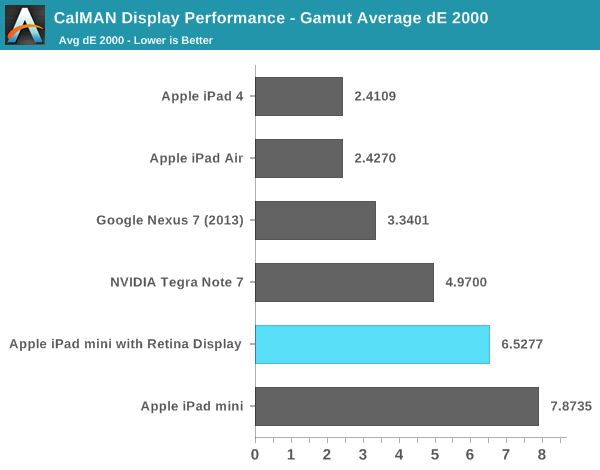
I suspect the justification here is Apple likely views the bigger iPad as being a better fit for photographers/those who care about color reproduction, but it’s a shame that this is a tradeoff that exists between the two iPads especially given how good Apple is about sRGB coverage in nearly all of its other displays.
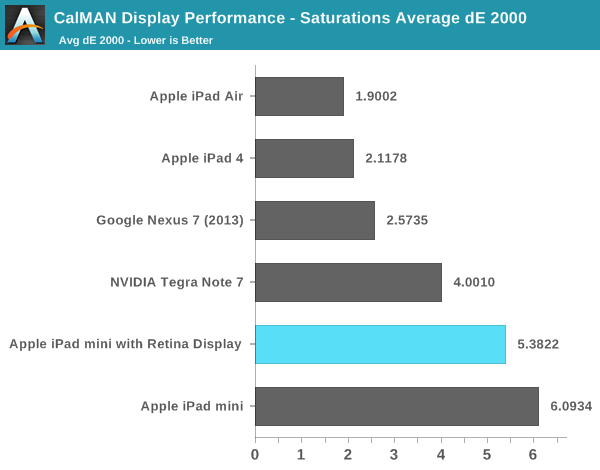

One of the simplest visual tests is to use one of iOS 7’s more colorful wallpapers and compare the Retina mini and iPad Air side by side:
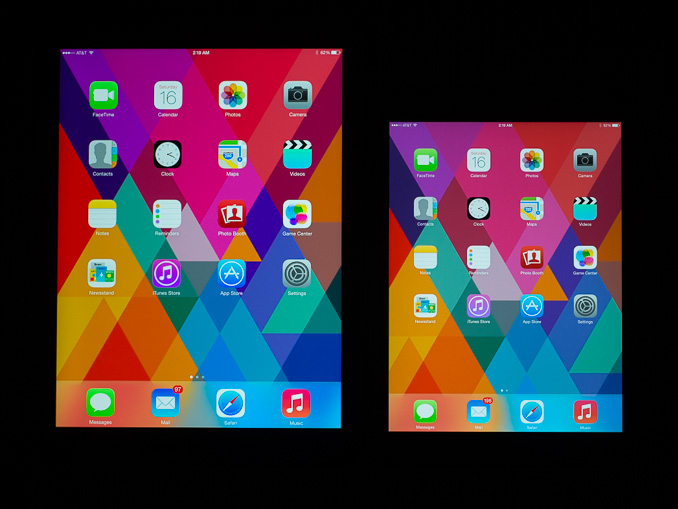
Pay attention to the color of the red triangles in the lower left
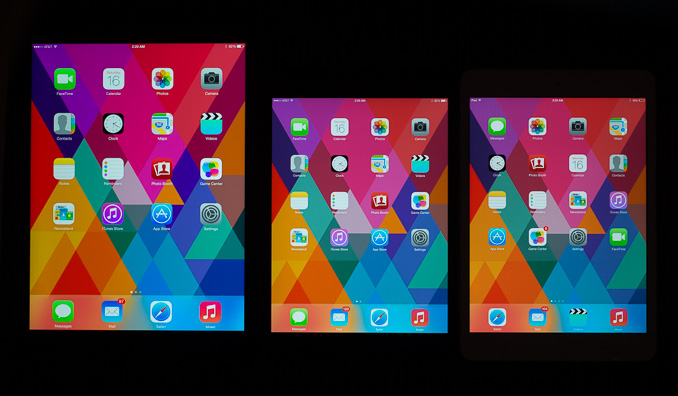
From left to right: iPad Air, iPad mini with Retina Display, iPad mini
The difference is small but apparent, particularly if you’re used to panels with full sRGB coverage like the iPad Air or any of the rMBPs/iMacs. The biggest deviations are in reds/blues and magenta in between as you can tell from the CIE chart above.

Within its gamut coverage, the mini’s panel is fairly accurate. A look at our GMB checker test shows performance competitive with the Nexus 7 and not far off the 4th generation iPad. Grayscale reproduction is also quite good. The display looks really good otherwise, but you don’t get the same visual punch you do on the iPad Air.
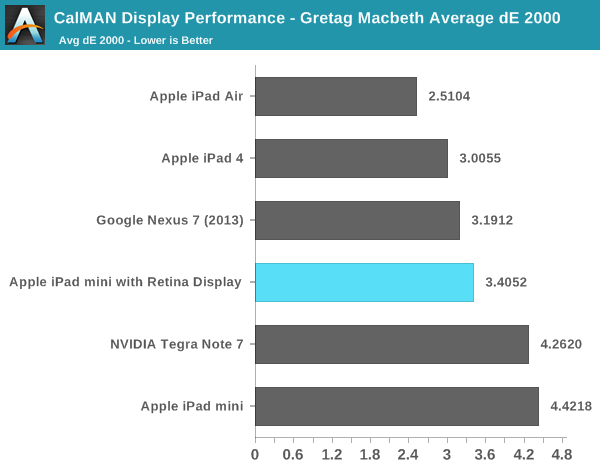

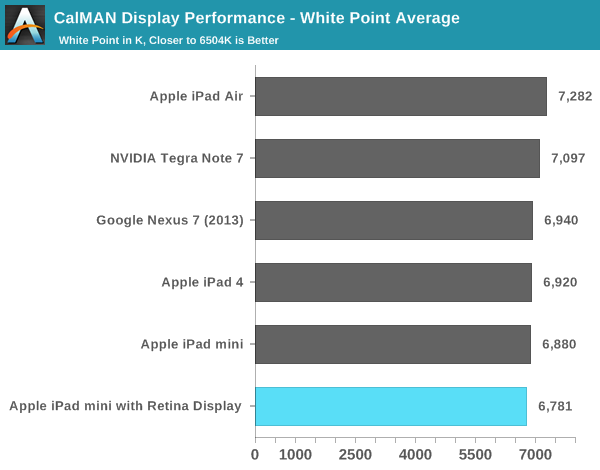
Compared to the previous generation mini we’re obviously talking about a much better panel. But for those of you on the fence between the mini and Air, the Air does still hold a display advantage.
Black levels are competitive and contrast ratio stays fixed at around 800:1 regardless of whether we’re talking about max brightness or the 200 nits we run all of our battery life tests at. Max brightness is down a bit compared to the iPad Air.
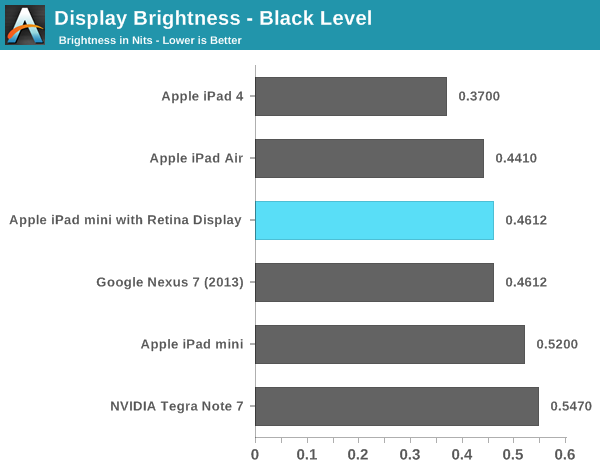
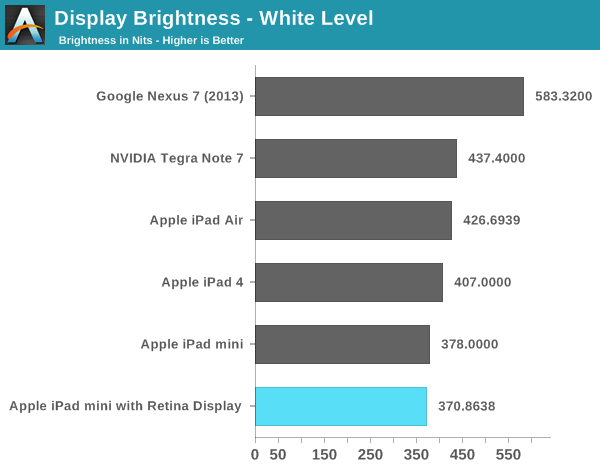
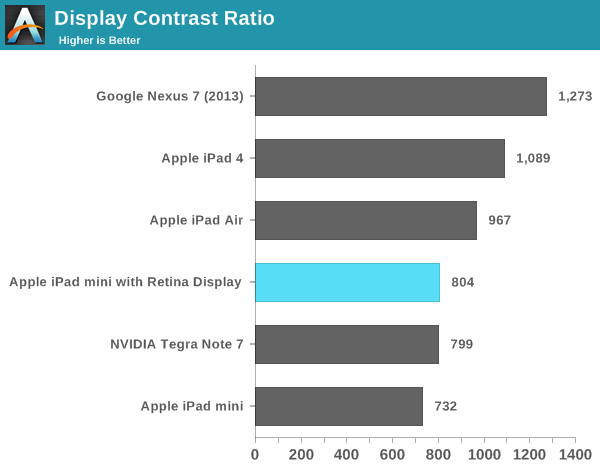










345 Comments
View All Comments
solipsism - Sunday, November 17, 2013 - link
It's the best product for my needs even though other, cheaper tablets that sell at a lot less volume do have better color gamut and higher PPI.ruggia - Saturday, November 16, 2013 - link
yes and yet, they no longer receive pre-release review units Apple anymore.ruggia - Saturday, November 16, 2013 - link
*from Applesolipsism - Sunday, November 17, 2013 - link
the terms "yet" and "because" are very different between your two comments.pliablemoosethebanned - Sunday, November 17, 2013 - link
No one knows for sure why The Verge doesn't get Apple sponsored review units any longer (they're not talking), but it's likely Josh's rant about iOS 7 violated the NDA they signed.cheinonen - Sunday, November 17, 2013 - link
Yeah, so I'll chime in on this. Without samples, review sites won't exist. As to every concern people have over those, they really aren't valid.- "If you don't give them a good review they won't send stuff anymore." Fine, that's a company shooting themselves in their own foot. No more reviews of their stuff, no more publicity, nothing.
- "Companies will rig samples." And if they do, they wind up getting caught, and the fallout is much worse than if their product was bad to start.
Would it be nice to be Consumer Reports and go out and buy everything? Sure, but they're in financial trouble now. Can I afford to go buy $1,500+ in monitors every month to do a review? No. And reviews of displays from NEC or 4K monitors would never happen as that's unaffordable. You'd wind up getting your reviews from a single site that can afford them instead of a huge swath of them.
So if you read a site that never says anything negative (and I don't read a LOT of audio sites for this reason), then stop reading it. But perhaps do a bit of research before you accuse everyone of being on the take and biased.
doubledeej - Monday, November 18, 2013 - link
Companies don't have to keep the products they buy (unless they destroy them, obviously). They can resell them for a minimal loss after they're done.The system we have for reviews is flawed. There is implied (if not real) pressure from companies to write a good review when they provide a product for you. Many companies (including Apple, BTW) will contact a reviewer after a bad review and chew them out for being less than flattering. It absolute happens. It is well documented. It can easily lead to incomplete reviews at best and outright dishonesty at the worst.
In the case of the iPad Mini with Retina Display, go take a look at the review at Ars Technica. It is the most unbiased one I've seen, while still being very favorable.
Death666Angel - Saturday, November 16, 2013 - link
"The face of the tablet is marked by an asymmetric bezel"Looks pretty symmetrical to me: the left and right bezel is the same size and the top and bottom bezels look the same size as well. :)
kyuu - Saturday, November 16, 2013 - link
Not sure if you're being serious or not, but Anand is obviously referring to the fact that the bezels aren't of equal thickness on all four sides of the device, as they generally are on tablets.piroroadkill - Saturday, November 16, 2013 - link
Does this overpriced shiny shit really do it for anyone anymore? I mean, come the fuck on..